
current / archive / issues / faq / RSS feed / twitter /
Blog Archive: July 2018
Doomenstein!There's a whole heap of Doctor Doom in this comic - he's there on the cover, and then he pops up in the first story, a parody of 'Camelot' featuring Thor, called 'Comicloct'.
Early on in this story there's a gathering of supervillains which, unusually,does not feature Doom amongt them.
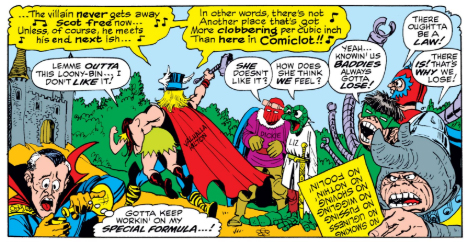 However, it seems that this time around Roy Thomas and Marie Severin are spreading the villains out, as he appears on the very next page along with other characters who weren't in the preceding group.
However, it seems that this time around Roy Thomas and Marie Severin are spreading the villains out, as he appears on the very next page along with other characters who weren't in the preceding group.
 As I keep saying, he's there as a representative of supervillains, not necessarily as the character of Doctor Doom himself. This is made even more clear in his other main appearance, as 'Doctor Doomenstein' in a retelling of the Hollywood version of 'Frankenstein'.
As I keep saying, he's there as a representative of supervillains, not necessarily as the character of Doctor Doom himself. This is made even more clear in his other main appearance, as 'Doctor Doomenstein' in a retelling of the Hollywood version of 'Frankenstein'.
Apart from living in a castle and looking the same, 'Doomenstein' has no resemblance to Doctor Doom, although there are similarities to recent versions of 'Dr Bloom' seen in this series, in that he speaks with a 'comedy' German accent, again probably referencing 'Wolfgang' from 'Rowan and Martin's Laugh-In'.
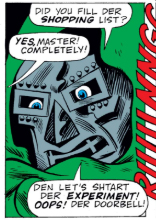 Between these two stories there's yet another appearance, alongside perennial 'Not Brand Echh' favourite Aunt May in a 'Puzzles' section.
Between these two stories there's yet another appearance, alongside perennial 'Not Brand Echh' favourite Aunt May in a 'Puzzles' section.
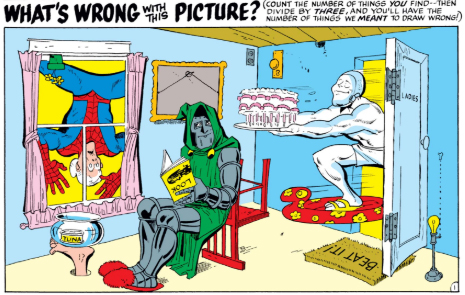 Doom sits wearing comfy slippers, reading a magazine - the 'humour' coming from the juxtaposition with his usual role as the ultimate supervillain. This has been how he's been used throughout this series, as a representative of supervillainy whose position is secure enough to be mocked without need for explanation.
Doom sits wearing comfy slippers, reading a magazine - the 'humour' coming from the juxtaposition with his usual role as the ultimate supervillain. This has been how he's been used throughout this series, as a representative of supervillainy whose position is secure enough to be mocked without need for explanation.
In the mainstream Marvel Universe between the publishing dates of March 1967 and March 1969 Doctor Doom only appeared as a main character (as opposed to cameo or parody) in two issues of Daredevil. However, during the same period he appeared in nine issues of 'Not Brand Echh', often several times per issue. It's thus a mark of how well established he is in his position as Number One Baddy that it can survive this constant mockery with very little reinforcement of his 'proper' role elsewhere.
There's just one issue of 'Not Brand Echh' to go - it's been interesting reading them, but I must say I'm very glad that next time we'll be returning to the pages of 'The Fantastic Four' for 'The Name Is Doom'!
posted 30/7/2018 by MJ Hibbett
(click here for permanent link)
(0) comments
Super-hero Daydreams
This is another double-sized issue, which sees 'Not Brand Echh' moving further away from its origins in self-mocking re-tellings of Marvel's own stories, towards something much more like 'Mad' Magazine, but with added superheroes. Half the stories here are parodies of TV shows and movies (with a sprinkling of added superheroes) while the rest either mock other company's characters (including Aquaman and Snoopy) or talk about the work of comic creators themselves.
One particularly interesting strip is in the 'Auntie Goose Rhymes' section, where Aunt May (who, as I've noted before, appears all over the place in this series, as if the creators either think an elderly woman is inherently funny, or that their readers do) 'reads' nursey rhymes about the 'Marble' characters and creators. Doctor Doom appears in the 'engraved border' for the first page of the strip along with several other characters, although he's the only super-villain represented.
 One of the rhymes is a tribute to Jack Kirby, and his ability to keep creating amazing characters. It's only one page long, and I think it's worth including here in full:
One of the rhymes is a tribute to Jack Kirby, and his ability to keep creating amazing characters. It's only one page long, and I think it's worth including here in full:
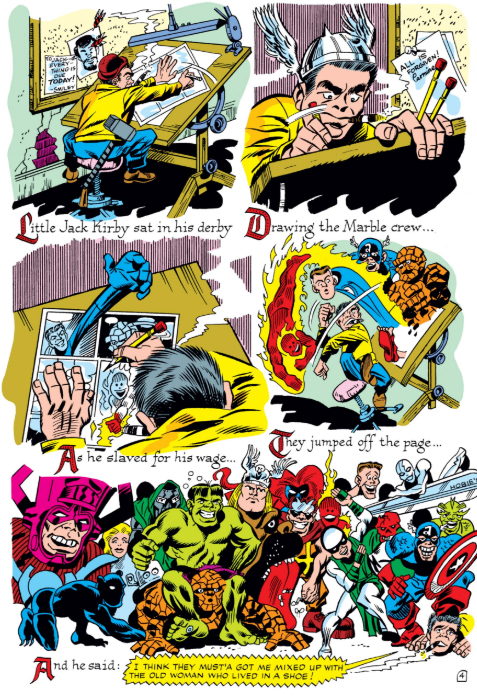 Apart from the fact that Doctor Doom appears here in his usual prominent position amongst the other leading characters of the day, it's also interesting because it's not actually drawn by Jack Kirby, it's by John Verpoorten, and it's written by Roy Thomas rather than Stan Lee, who you'd usually expect to be the one buttering Kirby up in print. This comic came out only a year before Kirby left Marvel, at a time when he was already becoming discontented with the credit he received for creating all of these characters, as well as the payment. The fact that it's Roy Thomas, a former fan, writing this tribute is perhaps a precursor to the fights by fans through the 70s and 80s to get recognition for the artist, in the face of opposition from Marvel itself.
Apart from the fact that Doctor Doom appears here in his usual prominent position amongst the other leading characters of the day, it's also interesting because it's not actually drawn by Jack Kirby, it's by John Verpoorten, and it's written by Roy Thomas rather than Stan Lee, who you'd usually expect to be the one buttering Kirby up in print. This comic came out only a year before Kirby left Marvel, at a time when he was already becoming discontented with the credit he received for creating all of these characters, as well as the payment. The fact that it's Roy Thomas, a former fan, writing this tribute is perhaps a precursor to the fights by fans through the 70s and 80s to get recognition for the artist, in the face of opposition from Marvel itself.
Doom makes two more appearances, both cameos in his position as 'representative of terrifying supervillainy'. The first is in a strip called 'Super-hero daydreams' where a small boy imagines being able to transform into Doctor Doom by uttering the magic word 'Shamarvey'.
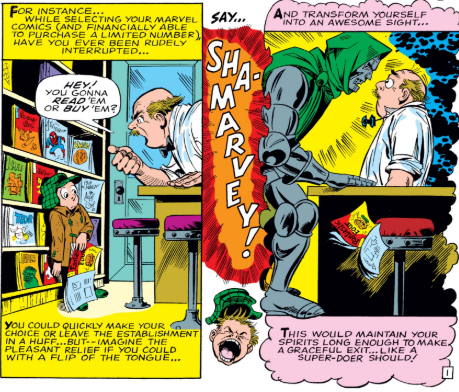 The other is in a barely comprehensible strip called 'It's A Mad, Mad Ave!' I think the idea is that all the Marble superheroes (and some villains) work in an advertising agency and can only speak in terms of advertised products... but then reply as if they're normal people off the street who don't know what's going on. Doctor Doom appears in the large pay-off panel where... er... everybody has a big fight.
The other is in a barely comprehensible strip called 'It's A Mad, Mad Ave!' I think the idea is that all the Marble superheroes (and some villains) work in an advertising agency and can only speak in terms of advertised products... but then reply as if they're normal people off the street who don't know what's going on. Doctor Doom appears in the large pay-off panel where... er... everybody has a big fight.
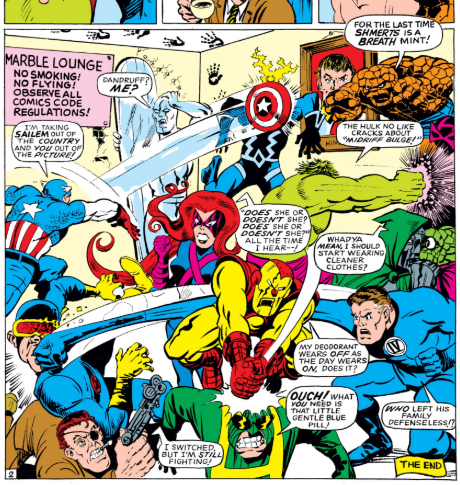 What all this shows, yet again, is that Doctor Doom is accepted as such an important part of the Marvel Universe that he has to be included on most occasions when there's a group shot, and is used as the main representative of supervillains. It also shows that I'm getting really fed up of reading 'Not Brand Echh' - just one more to go!
What all this shows, yet again, is that Doctor Doom is accepted as such an important part of the Marvel Universe that he has to be included on most occasions when there's a group shot, and is used as the main representative of supervillains. It also shows that I'm getting really fed up of reading 'Not Brand Echh' - just one more to go!
posted 23/7/2018 by MJ Hibbett
(click here for permanent link)
(0) comments
And Time, The Rushing River
This story sees Roy Thomas use Ray Bradbury's 'A Sound Of Thunder' for inspiration, as The Avengers return from a time travel adventure (using Doctor Doom's time machine) to discover that their actions have had dire repercussions for the present day.
When they return to their own time they discover a world subtly changed, not least by the fact that the original members of The Avengers are still together, and very surprised to see them. After a lot of research using a history-telling device called a 'Herodotron' they discover that in this new reality a mysterious figure called The Scarlet Centurion turned up at the end of The Avengers' first adventure and offered them an end to famine, plague and pestilence, in exchange for imprisoning all other superheroes.
 The Avengers have a meeting about it and decide to give it a go. After all, if he's lying then The Avengers themselves will still be around to stop him, so no harm done, right? You know, apart from beating up and imprisoning every other superhero, which is precisely what they go out and do.
The Avengers have a meeting about it and decide to give it a go. After all, if he's lying then The Avengers themselves will still be around to stop him, so no harm done, right? You know, apart from beating up and imprisoning every other superhero, which is precisely what they go out and do.
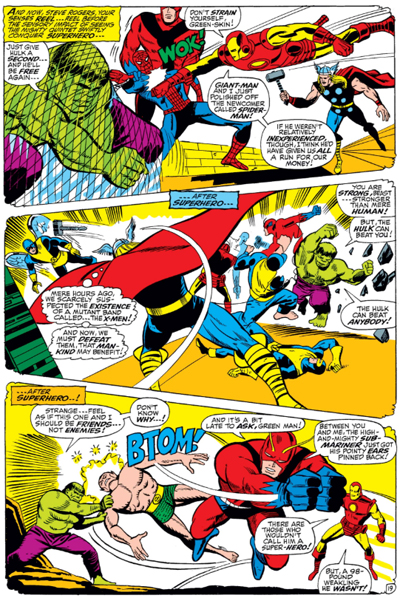 It's all supremely daft, but they think they're doing the right thing and, once every other superhero is overcome they go and duff up all of the supervillains, just to be sure.
It's all supremely daft, but they think they're doing the right thing and, once every other superhero is overcome they go and duff up all of the supervillains, just to be sure.
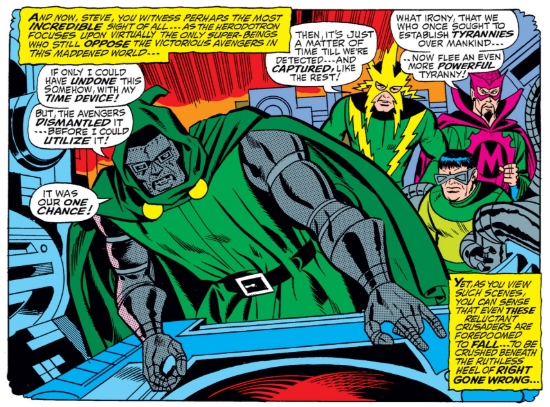 Doctor Doom, Electro, Doctor Octopus and The Mandarin were the last super-powered beings left at liberty to fight the Avengers, and though we don't see exactly how they were eventually defeated, we are told that they definitely were, with this panel the only mention of them in the issue. They're basically there to show how wrong The Avengers have become, that the Supervillains are now the ones fighting for liberty against super-powered oppression, whereas normally it would be the other way round.
Doctor Doom, Electro, Doctor Octopus and The Mandarin were the last super-powered beings left at liberty to fight the Avengers, and though we don't see exactly how they were eventually defeated, we are told that they definitely were, with this panel the only mention of them in the issue. They're basically there to show how wrong The Avengers have become, that the Supervillains are now the ones fighting for liberty against super-powered oppression, whereas normally it would be the other way round.
The interesting thing for me here is that Doctor Doom is being used once again as a signifier of super-villainy, grouped with other major supervillains in a very similar fashion to how he has been used recently in Not Brand Echh.
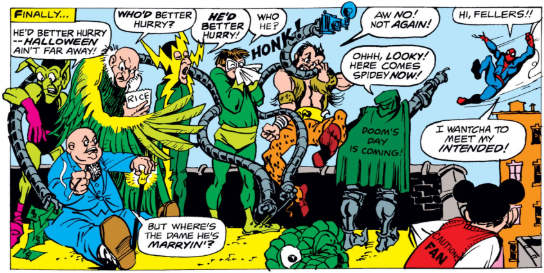 This is the first time he's been used this way in the main Marvel universe, even though this is actually an 'alternative' timeline rather than the 'real' one. As discussed previously, it definitely won't be the last time we seeing him heading up a representative group of villains, but it's interesting to see that this was a storytelling tool that was first used in a humour comic!
This is the first time he's been used this way in the main Marvel universe, even though this is actually an 'alternative' timeline rather than the 'real' one. As discussed previously, it definitely won't be the last time we seeing him heading up a representative group of villains, but it's interesting to see that this was a storytelling tool that was first used in a humour comic!
The Avengers travel back to Doom's old hideout, where his time machine was first demonstrated way back in Fantastic Four #5, which causes one of the team to remark how odd it is that the castle's still there in this reality.
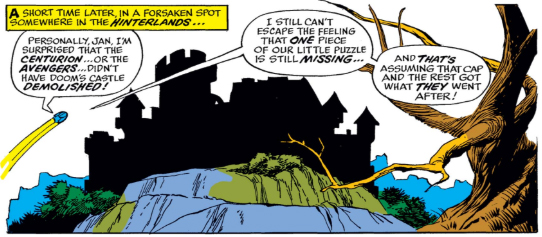 This is Roy Thomas using and old Stan Lee trick of pointing out how ridiculous a situation is, in order to get the reader to accept it!
This is Roy Thomas using and old Stan Lee trick of pointing out how ridiculous a situation is, in order to get the reader to accept it!
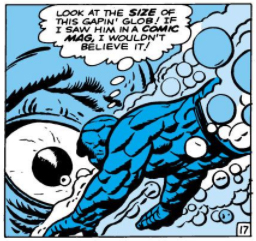 They cook up a plan to reset the timeline, which works so well that they themselves forget what has happened, although not before The Watcher turns up to give a brief explanation of who The Scarlet Centurion really is.
They cook up a plan to reset the timeline, which works so well that they themselves forget what has happened, although not before The Watcher turns up to give a brief explanation of who The Scarlet Centurion really is.
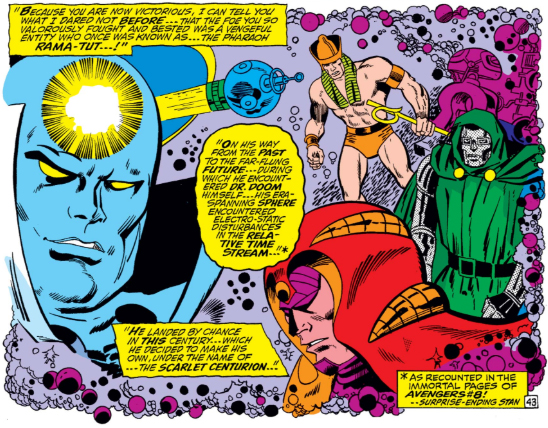 What the Watcher conveniently omits here is the idea that Rama Tut and Doctor Doom might actually be the same person from different points in time, as mentioned when they met back in Fantastic Four Annual #2.
What the Watcher conveniently omits here is the idea that Rama Tut and Doctor Doom might actually be the same person from different points in time, as mentioned when they met back in Fantastic Four Annual #2.
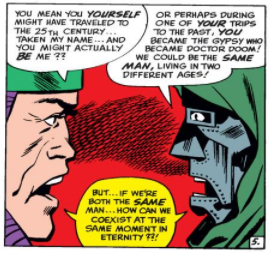 I imagine that The Watcher, seeing all as he does, thought that that was all too confusing to go into here, and I think he makes the right decision. The story ends with The Avengers flying off with no memory of what's gone on, as none of it technically happened at all.
I imagine that The Watcher, seeing all as he does, thought that that was all too confusing to go into here, and I think he makes the right decision. The story ends with The Avengers flying off with no memory of what's gone on, as none of it technically happened at all.
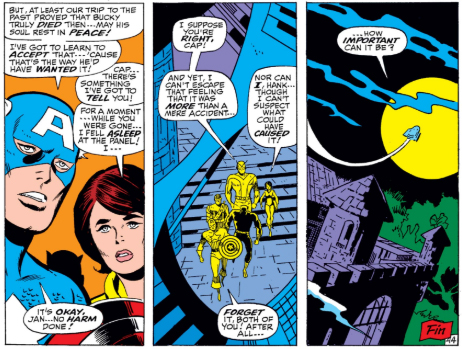 It's a neat, sci-fi twist, ending to the story, even if it does make you wonder a little bit why you bothered reading it!
It's a neat, sci-fi twist, ending to the story, even if it does make you wonder a little bit why you bothered reading it!
posted 18/7/2018 by MJ Hibbett
(click here for permanent link)
(0) comments
The Origin Of The Silver Surfer
After reading so much of 'Not Brand Echh' it's nice to read something in a Marvel comic that genuinely made me laugh... although I don't think it was meant to. It happened here, in the text to the splash page of 'Silver Surfer' #1.
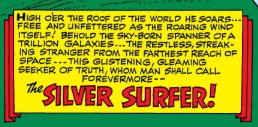 He's a Space Spanner! The rest of the issue is surprisingly short on laughs, as for once Stan Lee goes all in on the melodrama as the Silver Surfer tries to help mankind but is rejected again and again. As with Steranko's dialogue in the recent issue of Strange Tales everything is overwrought, self-pitying, and melodramatic, but (also as with that issue) it sort of works. John Buscema's art is gorgeous throughout, echoing the text with character poses that are forever straining away like ancient statues, conveying a feeling of power combined with emotional extremity.
He's a Space Spanner! The rest of the issue is surprisingly short on laughs, as for once Stan Lee goes all in on the melodrama as the Silver Surfer tries to help mankind but is rejected again and again. As with Steranko's dialogue in the recent issue of Strange Tales everything is overwrought, self-pitying, and melodramatic, but (also as with that issue) it sort of works. John Buscema's art is gorgeous throughout, echoing the text with character poses that are forever straining away like ancient statues, conveying a feeling of power combined with emotional extremity.
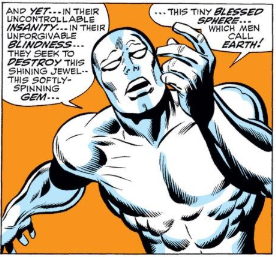 Over the course of the story the Surfer narrates his own origin story, mixed in with a recap of his adventures so far on Earth, which of course includes his meeting with Doctor Doom the year before in The Fantastic Four. Here we get to see the Surfer's side of the story, which features Doom being silent and the Surfer having no way of knowing that he'd turn out to be evil.
Over the course of the story the Surfer narrates his own origin story, mixed in with a recap of his adventures so far on Earth, which of course includes his meeting with Doctor Doom the year before in The Fantastic Four. Here we get to see the Surfer's side of the story, which features Doom being silent and the Surfer having no way of knowing that he'd turn out to be evil.
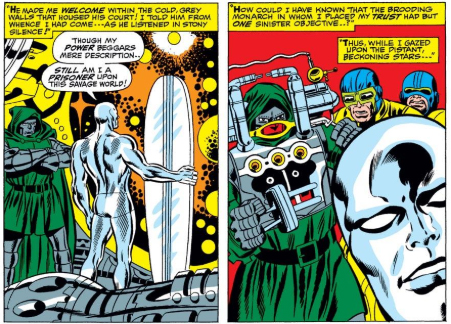 I'd suggest that having the Power Cosmic might have made you a better judge of character, especially of armoured monarchs called 'Doctor Doom', but maybe the Surfer's right. He comes across as a slightly unattractive character in his flashbacks, especially when he's shown in his former life on Zenn-La. He spends so much time moaning about how easy and BORING his idyllic life is that he almost seems pleased when Galactus turns up to eat his planet and kill everyone he's ever known, as it's at least something to do. Similarly when he takes on the role of Galactus' herald, he claims that he'll do it to save further lives, when really it's just so he can get some cosmic kicks.
I'd suggest that having the Power Cosmic might have made you a better judge of character, especially of armoured monarchs called 'Doctor Doom', but maybe the Surfer's right. He comes across as a slightly unattractive character in his flashbacks, especially when he's shown in his former life on Zenn-La. He spends so much time moaning about how easy and BORING his idyllic life is that he almost seems pleased when Galactus turns up to eat his planet and kill everyone he's ever known, as it's at least something to do. Similarly when he takes on the role of Galactus' herald, he claims that he'll do it to save further lives, when really it's just so he can get some cosmic kicks.
Whatever the reason, Doctor Doom does not feature any further in this story, and does not even speak - something which will be rectified at last when we see him next!
posted 16/7/2018 by MJ Hibbett
(click here for permanent link)
(0) comments
Casey At The Bat
At this point in the series 'Not Brand Echh' had gone double-sized on a bi-monthly publication schedule, increasing the page count in an attempt to be more like 'Mad'. It even has a contents page, unlike (nearly?) all other Marvel comics of the time.
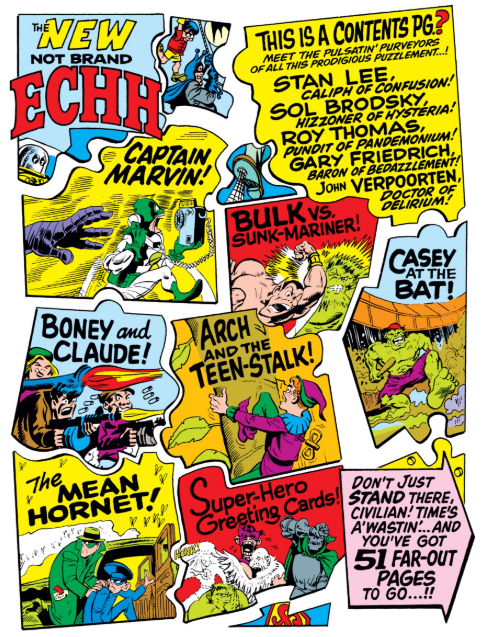 Doom's first appearance is in an adaptation of the poem 'Casey At The Bat'. I must admit I had to look this one up - it's one of those (very few) pieces of American culture which haven't made it into the public consciousness over on this side of the Atlantic, possibly because it was never mentioned in an episode of 'Friends'! It's a nineteenth century poem about baseball, which is 'recited' faithfully here, with the humour coming from the use of comics characters and their commentary on what's going on.
Doom's first appearance is in an adaptation of the poem 'Casey At The Bat'. I must admit I had to look this one up - it's one of those (very few) pieces of American culture which haven't made it into the public consciousness over on this side of the Atlantic, possibly because it was never mentioned in an episode of 'Friends'! It's a nineteenth century poem about baseball, which is 'recited' faithfully here, with the humour coming from the use of comics characters and their commentary on what's going on.
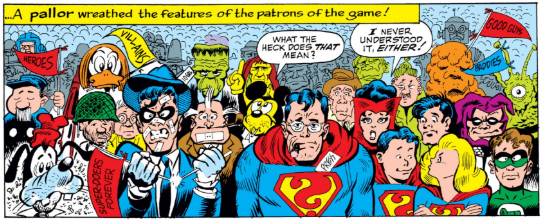 For some reason Doctor Doom talks in a German accent throughout the story. He's never done this in any of the comics, so I imagine it's an attempt to make it even MORE hilarious (NB I am now heartily fed up with 'Not Brand Echh' by this point, so that is definitely sarcasm) by referencing the Wolfgang character in 'Rowan And Martin's Laugh-In'. This character also appears on the front cover of Not Brand Echh #11 in another example of the growing focus on TV parodies as the series attempts to further mimic 'Mad' .
For some reason Doctor Doom talks in a German accent throughout the story. He's never done this in any of the comics, so I imagine it's an attempt to make it even MORE hilarious (NB I am now heartily fed up with 'Not Brand Echh' by this point, so that is definitely sarcasm) by referencing the Wolfgang character in 'Rowan And Martin's Laugh-In'. This character also appears on the front cover of Not Brand Echh #11 in another example of the growing focus on TV parodies as the series attempts to further mimic 'Mad' .
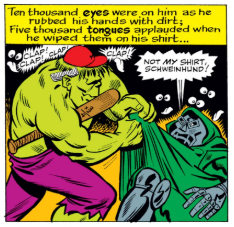
Doom shows up again in a couple of 'Super-Hero Greeting Cards'.
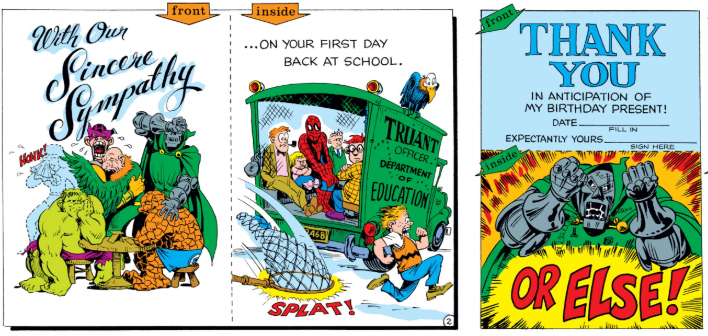 As in most of Doom's appearances in 'Not Brand Echh', they don't refer to his actual character, rather using him as a signifier for all Super-Villains. In most cases another villain like Magneto or Doctor Octopus could have been used instead, but it's generally Doctor Doom who's used when a baddie's needed. It doesn't make for hilarious reading, but it does show how important he is as a character, even though at the moment he's being used a lot more for this than for actual narrative action in the main Marvel universe!
As in most of Doom's appearances in 'Not Brand Echh', they don't refer to his actual character, rather using him as a signifier for all Super-Villains. In most cases another villain like Magneto or Doctor Octopus could have been used instead, but it's generally Doctor Doom who's used when a baddie's needed. It doesn't make for hilarious reading, but it does show how important he is as a character, even though at the moment he's being used a lot more for this than for actual narrative action in the main Marvel universe!
posted 11/7/2018 by MJ Hibbett
(click here for permanent link)
(0) comments
What Price Forbush-Man?
It's time for another visit to the world of 'Not Brand Echh', with Roy Thomas and John Verpoorten taking Forbush Man on a trip around this version of the Marvel Universe, meeting the likes of The Agents of Sheesh and The Echhs Men in what amounts to a forerunner of the line-wide crossovers which would start to become popular two decades later. It's interesting to note that we now see the same satirical versions of Marvel characters each time they appear in the comic - it's always "The Fantastical Four" or "The Revengers" rather than other versions of their names, and they always behave in the same ways, as if, even in a humour comic, the continuity of a shared storyworld is too hard to resist.
As before, Doctor Doom's appearance is as one member of a group of supervillains who attack Forbush Man and are foiled by him jumping down a manhole.
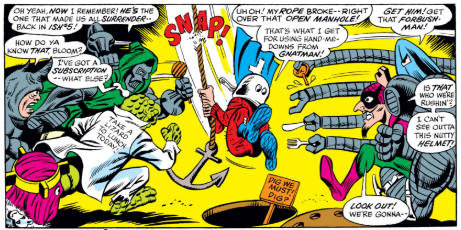 Again, this demonstrates Doom's primacy amongst supervillains and again this has echoes with J Michael Straczynski and John Romita Jr's Amazing Spider-man #36:
Again, this demonstrates Doom's primacy amongst supervillains and again this has echoes with J Michael Straczynski and John Romita Jr's Amazing Spider-man #36:
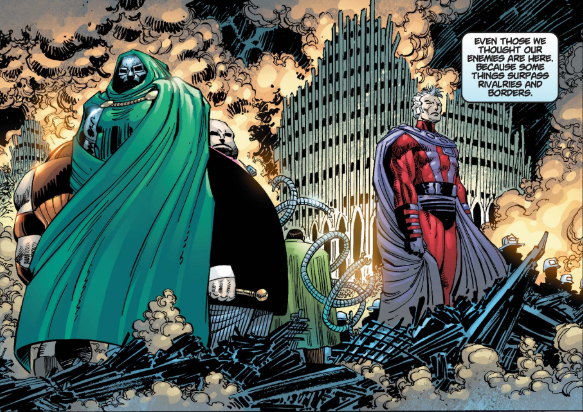 If there's ever a get together Doom's the one who's always got to be there to make it a proper gathering of supervillains. He's a figurehead for supervillainy, so in this case does not express many of his usually character traits, but we'll be seeing that in the next issue of Not Brand Echh when Doom... er... recognises his European roots!
If there's ever a get together Doom's the one who's always got to be there to make it a proper gathering of supervillains. He's a figurehead for supervillainy, so in this case does not express many of his usually character traits, but we'll be seeing that in the next issue of Not Brand Echh when Doom... er... recognises his European roots!
posted 9/7/2018 by MJ Hibbett
(click here for permanent link)
(0) comments
The Doom In The Room
This issue did not come up in any of my original data searches, because Doctor Doom doesn't actually appear, visually, anywhere in it. He is, however, mentioned a lot, so I think it needs to be included, while noting that this demonstrates both the need to read around the data and the primacy of the image over the dialogue in comics.
The biggest shock for me with this issue is that, after the psychedelic bombast of Steranko last time Kirby's artwork suddenly looks flat and old-fashioned. I'm used to it being exciting and fresh, but here it seems like old news.
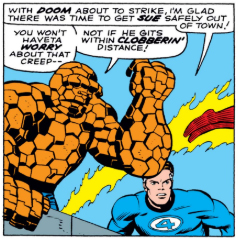 The story is a sort of retread of The Wedding Of Reed and Sue from Fantastic Four Annual #3 except with even MORE continuity. It starts with Daredevil swinging in from the end of the previous issue of his own series and meeting Thor, who has come straight from events in his own title. Spider-man quickly joins them, and Daredevil tells the group that Doctor Doom has taken over Reed Richard's body (he hasn't, that was just a Cunning Fib by Doom at the end of his last appearance). They then go and fight the three male members of the FF (Sue is on pre-maternity leave) who, in a classic comics misunderstanding, believe that Daredevil is actually Doctor Doom and the other two are some allies in disguise.
The story is a sort of retread of The Wedding Of Reed and Sue from Fantastic Four Annual #3 except with even MORE continuity. It starts with Daredevil swinging in from the end of the previous issue of his own series and meeting Thor, who has come straight from events in his own title. Spider-man quickly joins them, and Daredevil tells the group that Doctor Doom has taken over Reed Richard's body (he hasn't, that was just a Cunning Fib by Doom at the end of his last appearance). They then go and fight the three male members of the FF (Sue is on pre-maternity leave) who, in a classic comics misunderstanding, believe that Daredevil is actually Doctor Doom and the other two are some allies in disguise.
Like I said, Doctor Doom doesn't actually appear in this issue, but he is mentioned a LOT! Of course, none of the superheroes take the time to discuss the matter, or even try to explain that they really are who they look like, and a colossal punch-up ensues which only comes to an end on the penultimate page when Sue turns up and separates them all with her force fields.
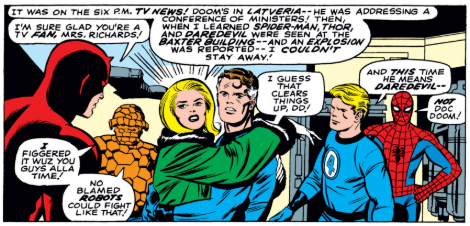 She know Daredevil can't be Doctor Doom because she's just seen a live report on TV, showing Doom in Latveria, addressing a conference of ministers. One might think that this was an oversight of Doom's - his whole plan was to trick the heroes into fighting each other, so it was a bit daft to go on telly and give the game away - but then again, how could he possibly be in Latveria? This issue takes place immediately after Daredevil #37 where Doom was specifically shown, on multiple occasions, to be in New York City. The whole story in the current issue can't have taken more than half an hour, which is nowhere near time for Doom to leave the embassy, fly to Latveria, and then prepare his notes sufficiently for a meeting, so what's going on?
She know Daredevil can't be Doctor Doom because she's just seen a live report on TV, showing Doom in Latveria, addressing a conference of ministers. One might think that this was an oversight of Doom's - his whole plan was to trick the heroes into fighting each other, so it was a bit daft to go on telly and give the game away - but then again, how could he possibly be in Latveria? This issue takes place immediately after Daredevil #37 where Doom was specifically shown, on multiple occasions, to be in New York City. The whole story in the current issue can't have taken more than half an hour, which is nowhere near time for Doom to leave the embassy, fly to Latveria, and then prepare his notes sufficiently for a meeting, so what's going on?
Here's my No-Prize application: we don't actually see the news report Sue is talking about, so maybe she's just made it up, as a way of pointing out that everyone is clearly who they say they are, without making the men feel too silly?
As with last time, Doom's actual presence in the comic may be tiny, but we still get several of his defining characteristics - his cunning, his leadership of Latveria, and his immunity from prosecution - even if they're only related by other parties. By this point Doom is so recognisably Doom that he doesn't even need to be shown to make his mark!
posted 6/7/2018 by MJ Hibbett
(click here for permanent link)
(0) comments
Armageddon!
Crikey. If going from Kirby to Colan felt like a jolt, going from 'Not Brand Ecch' to Jim Steranko is a serious case of psychedlic whiplash. This stuff is far out!
It feels especially FAR OUT because it STILL looks like an experimental freakout despite the fact that it's fifty years old and is widely reported as one of THE far out experimental freakouts. I often feel disappointed when allegedly KRAZY texts turn out not to be so, but there is no dissapointment here!
Right from the first page it's clear that Steranko has taken the Marvel Style of experimentation and histrionics and CUBED it. I mean, look at Jimmy Woo's dialogue on the first page:
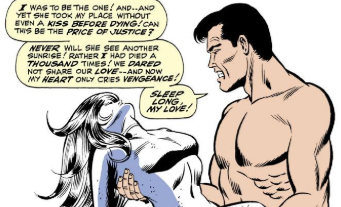 His girlfriend has been murdered, and THIS is what he says. It's like someone condensed Stan Lee until he was ten times normal strength and then served it up neat!
His girlfriend has been murdered, and THIS is what he says. It's like someone condensed Stan Lee until he was ten times normal strength and then served it up neat!
There's a whole heap more of this as the issue goes on, including an incredible four (4!) page spread, an infinity drive warping space and time as it enters nucelo-phoretic space, psychic storms, stunning colouring effects (especially for the time) and visuals that dare to take Kirby's stylings and crank them up even higher.
 It's an astonishing tour de force, which does not feature Doctor Doom until the very last double splash page, when it is revealed that Nicky Fury's epic battle with The Yellow Claw, which has taken up this entire issue, was simply a game between Doom and The Prime-Mover, a robot that he built for the purpose of playing games with. Basically, it's all been a single player campaign which Doom lost at the very end. Let's hope he saved his progress!
It's an astonishing tour de force, which does not feature Doctor Doom until the very last double splash page, when it is revealed that Nicky Fury's epic battle with The Yellow Claw, which has taken up this entire issue, was simply a game between Doom and The Prime-Mover, a robot that he built for the purpose of playing games with. Basically, it's all been a single player campaign which Doom lost at the very end. Let's hope he saved his progress!
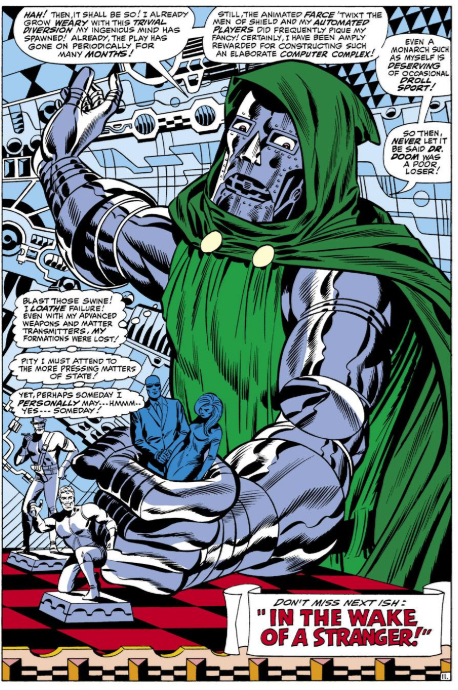 It's just a single panel, but still Steranko squeezes in a lot of Doom characteristics - his arrogance, his hatred of losing, his leadership of Latveria, and his delight in toying with people from a distance. If only he'd flung himself out of an airship whilst comparing himself to Reed Richards we'd have had the full set!
It's just a single panel, but still Steranko squeezes in a lot of Doom characteristics - his arrogance, his hatred of losing, his leadership of Latveria, and his delight in toying with people from a distance. If only he'd flung himself out of an airship whilst comparing himself to Reed Richards we'd have had the full set!
posted 4/7/2018 by MJ Hibbett
(click here for permanent link)
(0) comments